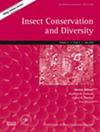Vertical stratification of leaf physical traits exerts bottom–up pressures on insect herbivory in a sugar maple temperate forest
IF 3.2
2区 农林科学
Q1 ENTOMOLOGY
引用次数: 0
Abstract



叶片物理特征的垂直分层对糖槭温带森林中昆虫的食草性产生自下而上的压力
温带森林的光垂直梯度是否会影响昆虫食草动物群落的结构?我们测试了这样一个假设:从林下到林冠,光照强度的增加推动了叶片物理性状和芽绽表型的差异,而这些差异会影响昆虫食草动物,从而在食草动物群落结构及其造成的叶片损害中发挥作用。了解这些相互作用对于填补温带落叶林生态系统动态方面的知识空白至关重要。在 2020 年、2021 年和 2022 年的夏天,我们对魁北克南部的 12 个糖枫(Acer saccharum)地点进行了监测,研究了从林下幼苗到成熟树荫和阳光树冠(强度最高,树冠覆盖率最低)的昆虫食草动物模式。此外,我们还记录了叶片的物理特征和阳光照射情况。我们的研究结果表明,2021年叶片厚度沿垂直梯度增加,使得树冠中的成熟树叶比林下树苗叶片更不利于食草动物。因此,我们记录到 2020 年和 2021 年从林下树冠到遮荫树冠再到向阳树冠,昆虫的食草动物危害率持续下降,其驱动力是切叶虫、镂空虫、刺吸虫和潜叶虫。这些结果支持了我们的假设,即叶片物理性状的变化有助于昆虫危害的垂直分层。这种叶片特征的变化可能与光照水平或树木的生长发育有关。2022 年,昆虫食草动物的丰度梯度与前几年观察到的危害趋势相吻合。我们计算出研究地点的年平均草食率为叶面的9.1%。总之,我们的研究突出了垂直梯度在昆虫食草动物群落结构中的重要性,并强调了叶片特征在这些相互作用中的中介作用。此外,年平均食草率表明,支持背景食草对糖槭树森林衰退有重要作用的证据有限。
本文章由计算机程序翻译,如有差异,请以英文原文为准。
求助全文
约1分钟内获得全文
求助全文
来源期刊
CiteScore
7.70
自引率
8.60%
发文量
58
审稿时长
>12 weeks
期刊介绍:
To publish papers of the highest scientific quality within the general area of insect (and other arthropods) conservation and diversity covering topics ranging from ecological theory to practical management.
Papers are invited on the following topics: Conservation genetics; Extinction debt; Long-term conservation planning and implementation; Global implications of local or national conservation actions; Management responses of species and communities; Captive breeding programs; Comparisons of restored and natural habitats; Biogeography; Global biodiversity; Metapopulation dynamics; Climate change: impacts on distributions and range; Invasive species: impacts and control; Effects of pollution; Genetic threats to diversity by introgression; Effects of fragmentation on diversity and distribution; Impact of agricultural and forestry practices on biodiversity; Enhancing urban environments for diversity and protection; Biodiversity action plans: can we scale up from insects?; Effectiveness and choice of indicator species; Soil biodiversity and interactions with above-ground biodiversity; Ecological interactions at local levels; Ecological and evolutionary factors influencing diversity and local, regional and global scales; Sustainable livelihoods and training on the ground; Integrating science and policy.

 求助内容:
求助内容: 应助结果提醒方式:
应助结果提醒方式:


